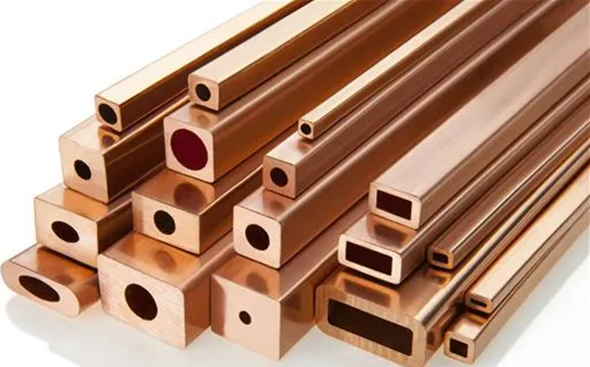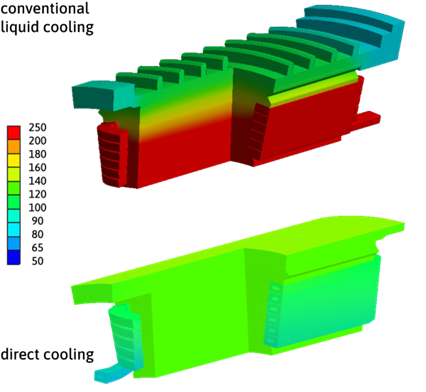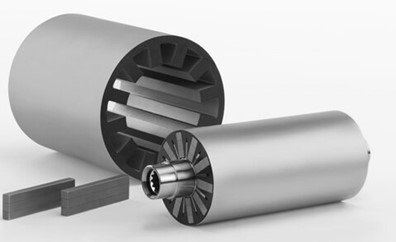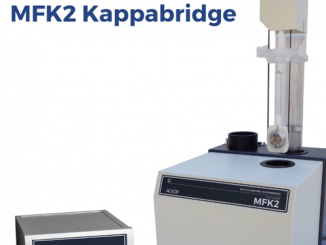
Direct-cooled motors with hollow conductor stators offer several advantages over the indirect-cooled motors currently used in EVs, says Luvata of Finland, which has been making copper hollow conductors for more than sixty years. Adoption of the technology, typically used in more exotic applications such as superconduction, high-energy physics and magnetic resonance imaging, into mass-market electric vehicles faces considerable technical obstacles, however, and much higher cost than conventional magnet wire.
Recently, Luvata has teamed up with a German motor engineering firm to help drive adoption of the technology. The partner, hyperdrives GmbH, is a Munich-based start-up that designs and tests electric drivetrains using oxygen-free copper hollow conductors from Luvata. Based in Pori, Finland, Luvata is a group company of Mitsubishi Materials Corp.
The attraction is that more effective cooling of the motor windings enables a higher power output, increased efficiency especially at partial loads, and the use of lower temperature grade permanent magnets, meaning smaller, more efficient motors can be built using cost-effective off-the-shelf materials. In electric motors, the current flows in the windings, which are made of copper because of its low resistance. Electrical losses are an unavoidable obstacle and increase with the amount of current; for example, doubling the current quadruples the losses, which increases heat in the motor. In addition, magnetic losses heat both the stator and the rotor, further increasing the heat load. This heat can be extracted by direct or indirect cooling. Luvata explains the case in a white paper available on its website, highlighted in this article.
Most smaller electric motors today use indirect cooling, as they have for more than a century. A cooling fluid, water glycol, in the motor housing transports heat to a heat exchanger where it is re-cooled by air before being returned to the housing. The drawback of this method is its limited heat flow, especially for the wire enamel and slot liner, which have low thermal conductivity. This can be seen in Figure 1, taken from a thermal simulation of conventional indirect liquid cooling.
Direct stator cooling using hollow conductors enables more efficient cooling as a cooling fluid or gas can be circulated in direct contact with the inside of the conductor. This allows for significantly higher stator currents and therefore smaller, more compact motors. The big benefit of this method is that it treats the heat where it is generated, in the winding itself instead of in the housing. Effective cooling of the stator also ensures a lower rotor temperature, enabling the use of less expensive lower temperature graded permanent magnets.
Hollow conductors in electric motors are not a fundamentally new invention. They have been used for decades in large electric motors and generators where the distance between the heat-generating winding and the coolant in the housing is too long for indirect cooling to be effective. However, with smaller motors the challenge up to now has been the dimensions of the conductor, as little as 1 mm, which increases manufacturing complexity and negatively affects coolant circulation causing high pressure demand on the pump side. Solving this challenge has paved the way for the use of hollow conductors in smaller direct-cooled motors.
Direct cooling offers the highest power density for an electric motor – especially continuous power output –alongside excellent efficiency over a broad range. Partial load is the most realistic use case for an electric motor, and tests conducted in an evaluation prototype created by hyperdrives have shown that a direct-cooled motor offers approximately twice the power output at peak load and three times the power output at continuous steady-state operation compared to a standard, indirect-cooled motor.

Direct cooling comes with new challenges, though, explains hyperdrives, such as high pressure in the hydraulic cooling system, sealing the connection joints, insulation properties of the cooling fluid and manufacturing processes. The general idea is simple but the real challenge is greater than just replacing conventional wire by hollow conductor, it notes.
A design using distributed windings is key, says hyperdrives, compared to concentrated windings as commonly used. Concentrated windings are fantastic at first glance, it notes. They have short end windings. They are easy to produce and to assemble. The downside, however, is that the magnetomotive force of basically all pole slot combinations creates a vast spectrum of harmonics. Winding harmonics produce additional losses, also, noise and vibration which are a potential killer criteria for many applications and probably a strong reason why these promising machine topologies have not made it in the EV mass market so far, says hyperdrive. Distributed windings, however, have a significantly lower pole number in relation to motor speed usually, thus, lower fundamental frequencies. For more info, see www.luvata.com for the full white paper, and www.hyperdrives.de.



